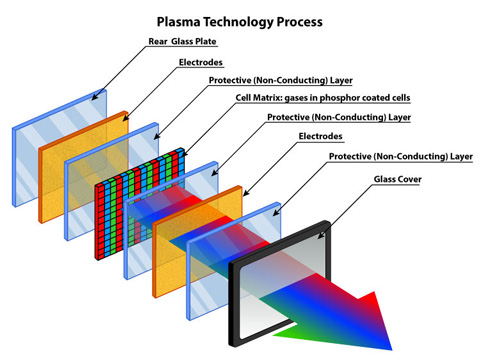What is Plasma TV?
A plasma TV is a high definition (HDTV) alternative to the standard cathode ray televisions sold today. It provides sharp images and vibrant colors, especially when used in conjunction with high definition broadcasts. Quite often a plasma screen is designed in a 16:9 ratio for wide screen movie formats, as opposed to the box-like 4:3 ratio of standard televisions. A quality plasma TV is not cheap, however.
One of the chief selling points of a plasma TV is a flat screen, which allows it to be mounted directly on a wall without a lot of clearance required. Investors in this type of TV may also employ surround-sound theater speakers and high-end receivers to complete the feeling of luxury. Plasma televisions have become status symbols among technophiles and other wealthy consumers.
The science behind a plasma TV is very complicated, so welcome to the geek_of_all school of oversimplification.
'Plasma' is a scientific term referring to gases like neon and xenon which glow when exposed to an electrical field. Plasma is sometimes called the fourth state of matter, after liquids, solids, and gases. Think of a neon sign or fluorescent light bulb to understand plasma as it applies here.
Televisions, in general, rely on thousands of small 'picture elements', abbreviated as pixels. With any color television, a bundle of three separate colors comprises one pixel, usually red, green and blue. By controlling the level of each color, all of the other colors of the spectrum can be produced in each pixel. The viewer is usually so far from the screen that the individual pixels blur into each other and the illusion of motion is created as they change color. This is true of any television system, plasma or otherwise.
In a plasma TV, the individual pixels are made from three tiny containers of an inert gas such as neon or xenon. There are literally hundreds of thousands of these tiny tubes on an average plasma screen. All of these individual pixels are sandwiched between two electrically-charged plates. Remember that plasma glows when exposed to an electrical current. A computer processing unit receives signals from a cable or broadcast antenna which tells it how to reassemble the entire picture hundreds of times per second.
 The computer controls the electrical field down to individual pixels, allowing different combinations of colors to glow. The viewer is usually not aware of all the changes because his or her brain is processing all of the information as a continuously moving image. Because a plasma TV screen contains quite a few more pixels than a standard television, the image is noticeably sharper. Each pixel combination can reproduce an exact hue, not a quick approximation. This means the colors are usually deeper and richer.
The computer controls the electrical field down to individual pixels, allowing different combinations of colors to glow. The viewer is usually not aware of all the changes because his or her brain is processing all of the information as a continuously moving image. Because a plasma TV screen contains quite a few more pixels than a standard television, the image is noticeably sharper. Each pixel combination can reproduce an exact hue, not a quick approximation. This means the colors are usually deeper and richer.
The main drawback of a plasma TV system is its vulnerability to damage. If a hard object strikes the screen, hundreds of individual gas-filled tubes instantly lose their ability to glow. Replacing all of those elements is a time-consuming and expensive process that it can be done at all. Owners of plasma systems should always consider purchasing insurance and extended warranties since the most common fix appears to be a total replacement of the screen. Because the gas forming the plasma can leak or become less reactive to electrical charges, plasma TV systems do have a limited shelf life. It may take several years before a noticeable change in picture quality, but the cumulative effects are similar to what happens in neon and fluorescent lighting-eventually the gas inside the tube will begin to flicker instead of burning steadily
/about/Sasmung-64H5000-Plasma-800-58ea92133df78c51624ae8a3.jpg)



Very Interesting and Informing. Keep up the good work :)
ReplyDeleteThinklikeart | www.thinkikeartsite.wordpress.com